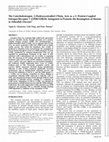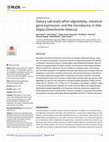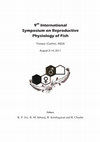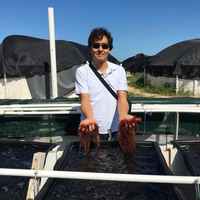Papers by Tapan Chourasia
<p>Similarity percentages (SIMPER) indicating the most abundant genera contributing to the ... more <p>Similarity percentages (SIMPER) indicating the most abundant genera contributing to the discrimination between groups.</p
<p>The physiological parameters <i>ADC lipid</i> and <i>atp1a3</i> ... more <p>The physiological parameters <i>ADC lipid</i> and <i>atp1a3</i> are plotted (green lines) as correlations with the PI microbiome of the treatments. The <i>ADC lipid</i> was positively correlating, and thus has a direction towards the SED group, while the <i>atp1a3</i> was negatively correlating with the SED group and thus positively with the CD group.</p

Biology of reproduction, Jan 21, 2015
Estradiol-17beta (E2) maintains high cAMP levels and meiotic arrest in zebrafish oocytes through ... more Estradiol-17beta (E2) maintains high cAMP levels and meiotic arrest in zebrafish oocytes through activation of G protein-coupled estrogen receptor, GPER. The catecholestrogen 2-hydroxyestradiol-17beta (2-OHE2) has an opposite effect to that of E2 on oocyte maturation (OM) and cAMP levels in Indian catfish oocytes. We tested the hypothesis that 2-OHE2 is produced in zebrafish ovaries and promotes the resumption of oocyte meiosis through its action as a GPER antagonist. Ovarian 2-OHE2 production by estrogen-2-hydroxylase (EH) was upregulated by gonadotropin treatment at the onset of OM, consistent with a physiological role for 2-OHE2 in regulating OM. The increase in EH activity and OM were blocked by treatment with CYP1A1 and CYP1B1 inhibitors. Expression of cyp1a, cyp1b1 and cyp1c mRNAs was increased by gonadotropin treatment, further implicating these Cyp1s in 2-OHE2 synthesis prior to OM. Conversely, aromatase activity and cyp19a1 mRNA expression declined during gonadotropin induc...
Aquaculture and Fisheries

PLOS ONE, Aug 23, 2018
Nile tilapia (Oreochromis niloticus) is the world's most widely cultured fish species. Therefore,... more Nile tilapia (Oreochromis niloticus) is the world's most widely cultured fish species. Therefore, its nutritional physiology is of great interest from an aquaculture perspective. Studies conducted on several fish species, including tilapia, demonstrated the beneficial effects of dietary salt supplementation on growth; however, the mechanism behind these beneficial effects is still not fully understood. The fish intestine is a complex system, with functions, such as nutrient absorption, ion equilibrium and acid-base balance that are tightly linked and dependent on each other's activities and products. Ions are the driving force in the absorption of feed components through pumps, transporters and protein channels. In this study, we examined the impact of 5% increase in dietary NaCl on protein, lipid, ash and dry matter digestibility, as well as on the expression of intestinal peptide transporters (PepTs) and ion pumps (Na + /K +-ATPase, V-H +-ATPase, N + /H +-Exchanger) in Nile tilapia. In addition, effects on the gut microbiome were evaluated. Our results show that dietary salt supplementation significantly increased digestibility of all measured nutritional components, peptide transporters expression and ion pumps activity. Moreover, changes in the gut microbial diversity were observed, and were associated with lipid digestibility and Na + /K +-ATPase expression.

Estradiol-17beta (E2) maintains high cAMP levels and meiotic arrest in zebrafish oocytes through ... more Estradiol-17beta (E2) maintains high cAMP levels and meiotic arrest in zebrafish oocytes through activation of G protein-coupled estrogen receptor, GPER. The catecholestrogen 2-hydroxyestradiol17beta (2-OHE2) has an opposite effect to that of E2 on oocyte maturation (OM) and cAMP levels in Indian catfish oocytes. We tested the hypothesis that 2-OHE2 is produced in zebrafish ovaries and promotes the resumption of oocyte meiosis through its action as a GPER antagonist. Ovarian 2-OHE2 production by estrogen-2-hydroxylase (EH) was upregulated by gonadotropin treatment at the onset of OM, consistent with a physiological role for 2-OHE2 in regulating OM. The increase in EH activity and OM were blocked by treatment with CYP1A1 and CYP1B1 inhibitors. Expression of cyp1a, cyp1b1 and cyp1c mRNAs was increased by gonadotropin treatment, further implicating these Cyp1s in 2-OHE2 synthesis prior to OM. Conversely, aromatase activity and cyp19a1 mRNA expression declined during gonadotropin induct...

Comparative biochemistry and physiology. Part A, Molecular & integrative physiology, Jan 27, 2018
Tilapiine species, widely distributed across habitats with diverse water salinities, are importan... more Tilapiine species, widely distributed across habitats with diverse water salinities, are important to aquaculture as well as a laboratory model. The effects of water salinity on two tilapia species, that differ in their salinity tolerance, was evaluated. Oreochromis niloticus reared in brackish-water, showed a significant decrease in growth and feed efficiency, whereas O. mossambicus reared in seawater did not show any significant changes. The expression and activity of Na/K-ATPase (NKA), V-type H-ATPase (VHA) and carbonic anhydrase (CA), as well as expression levels of genes encoding two HCOand three peptide transporters (nbc1, slc26a6, slc15a1a, slc15a1b and slc15a2) were measured in three intestinal sections of these two species, grown in freshwater and brackish/sea-water. Overall, the spatial distribution along the intestine of the genes examined in this study was similar between the two species, with the exception of tcaIV. The salinity response, on the other hand, varied great...

American Journal of Hematology, 2015
Mutations in the calreticulin gene (CALR) were recently identified in approximately 70-80% of pat... more Mutations in the calreticulin gene (CALR) were recently identified in approximately 70-80% of patients with JAK2-V617F-negative essential thrombocytosis and primary myelofibrosis. All frameshift mutations generate a recurring novel C-terminus. Here we provide evidence that mutant calreticulin does not accumulate efficiently in cells and is abnormally enriched in the nucleus and extracellular space compared to wildtype calreticulin. The main determinant of these findings is the loss of the calcium-binding and KDEL domains. Expression of type I mutant CALR in Ba/F3 cells confers minimal IL-3-independent growth. Interestingly, expression of type I and type II mutant CALR in a non-hematopoietic cell line does not directly activate JAK/STAT signaling compared to JAK2-V617F expression. These results led us to investigate paracrine mechanisms of JAK/STAT activation. Here we show that conditioned media from cells expressing type I mutant CALR exaggerate cytokine production from normal monocytes with or without treatment with a toll-like receptor agonist. These effects are not dependent on the novel C-terminus. These studies offer novel insights into the mechanism of JAK/STAT activation in patients with JAK2-V617F-negative essential thrombocytosis and primary myelofibrosis. This article is protected by copyright. All rights reserved.

Estradiol-17beta (E2) maintains high cAMP levels and meiotic arrest in zebrafish oocytes through ... more Estradiol-17beta (E2) maintains high cAMP levels and meiotic arrest in zebrafish oocytes through activation of G protein-coupled estrogen receptor (GPER). The catecholestrogen 2-hydroxyestradiol-17beta (2-OHE2) has an opposite effect to that of E2 on oocyte maturation (OM) and cAMP levels in Indian catfish oocytes. We tested the hypothesis that 2-OHE2 is produced in zebrafish ovaries and promotes the resumption of oocyte meiosis through its action as a GPER antagonist. Ovarian 2-OHE2 production by estrogen-2-hydroxylase (EH) was up-regulated by gonadotropin treatment at the onset of OM, consistent with a physiological role for 2-OHE2 in regulating OM. The increases in EH activity and OM were blocked by treatment with CYP1A1 and CYP1B1 inhibitors. Expression of cyp1a, cyp1b1, and cyp1c mRNAs was increased by gonadotropin treatment, further implicating these Cyp1s in 2-OHE2 synthesis prior to OM. Conversely, aromatase activity and cyp19a1 mRNA expression declined during gonadotropin induction of OM. 2-OHE2 treatment significantly increased spontaneous OM in defolliculated zebrafish oocytes and reversed the inhibition of OM by E2 and the GPER agonist G-1. 2-OHE2 was an effective competitor of [(3)H]-E2 binding to recombinant zebrafish GPER expressed in HEK-293 cells. 2-OHE2 also antagonized estrogen actions through GPER on cAMP production in zebrafish oocytes, resulting in a reduction in cAMP levels. Stimulation of OM by 2-OHE2 was blocked by pretreatment of defolliculated oocytes with the GPER antibody. Collectively, the results suggest that 2-OHE2 functions as a GPER antagonist and promotes OM in zebrafish through blocking GPER-dependent E2 inhibition of the resumption of OM.

In higher vertebrates like mammals, the ovary elicits high catecholaminergic activity that origin... more In higher vertebrates like mammals, the ovary elicits high catecholaminergic activity that originates either from extrinsic sympathetic innervation or intrinsic catecholaminergic system [1]. Ovarian innervation by the autonomic nervous system (ANS) has been described in a few teleosts and the innervations pattern shows considerable species variation . Recent, investigation from our laboratory has demonstrated that the catfish ovary is innervated by seven pairs of nerves, originating from the paired sympathetic chain lying dorsal to the posterior kidney. Further we demonstrated tyrosine hydroxylase (TH, the rate limiting enzyme in catecholamine synthesis) and catecholamine seasonal activities in the ovary of the catfish during the annual reproductive cycle [3, 4] implying a functional role in ovarian gametogenesis and ovulation. Previous studies have shown that steroid hormone secretion is regulated by catecholamines . However, investigations on the direct role of catecholamines in regulating ovarian steroid hormone levels are lacking. Since surgical denervation of the ovary, like in mammals is difficult. A pharmacological blocker to inhibit catecholaminergic activity was employed to investigate the role of catecholamines in ovarian function. The methylated derivative of tyrosine, Į-methyl paratyrosine (Į-MPT) is a competitive inhibitor of TH. This drug has been widely used as a pharmacological tool to investigate the CA metabolism . In the present study, post vitellogenic follicles were incubated in vitro with Į-MPT and steroid hormone levels were measured.

General and comparative endocrinology, 2012
Ovarian pieces containing postvitellogenic follicles were incubated in vitro with different conce... more Ovarian pieces containing postvitellogenic follicles were incubated in vitro with different concentrations of the catecholestrogen 2-hydroxyestradiol-17β (2-OHE(2)) to evaluate its effects on steroid production and germinal vesicle breakdown (GVBD) in the catfish Heteropneustes fossilis. The incubation with 2-OHE(2) induced a shift in steroidogenic pattern: the C(19) and C(18) steroids testosterone (T) and estradiol-17β (E(2)), respectively were significantly decreased with a concomitant significant increase in the C(21) steroids progesterone (P(4)), 17-hydroxyprogesterone (17-OHP), 17,20β-dihydroxy-4-pregnen-3-one (17,20β-DP), 17,20α-dihydroxy-4-pregnen-3-one (17,20α-DP) and cortisol (F). Concomitantly, the catecholestrogen induced dose-dependently GVBD response, the first sign of meiosis resumption. The co- and pre-incubations of the ovarian pieces with 2-OHE(2), and adrenergic (phentolamine, α-blocker and propranolol, β-blocker) or estrogen (tamoxifen) receptor blockers resulted in inhibition of the stimulatory effect of the catecholestrogen on C(21) steroids and reversed the inhibition of testosterone and E(2). The α-blocker was more effective than the β-blocker. Our results suggest that 2-OHE(2) appears to employ both adrenergic (α-type) and estrogen receptor mechanisms in mediating the effects. The co- or pre-incubation of ovarian pieces with IBMX (a cAMP elevating drug), H89 (a protein kinase A inhibitor), and PD098059 (a MAP kinase kinase inhibitor) significantly inhibited the stimulatory effect of 2-OHE(2) on the C(21) steroids. The effect of chelerythrine (a protein kinase C inhibitor), on the other hand, varied with the incubation condition. In the co-incubation, the steroids showed varied effects: 17,20β-DP, testosterone and E(2) were elevated, and P(4) and 17-OHP were decreased. In the pre-incubation set up, all the steroids were inhibited except E(2). The inhibition by the blockers was higher in the pre-incubation groups. Taken together, the data suggest the involvement cAMP-protein kinase A, protein kinase C and MAP kinase pathways in the modulation of the steroidogenic activity.

General and comparative endocrinology, 2012
Seasonal, periovulatory and 2-hydroxyestradiol-17β (2-OHE(2))-induced changes on ovarian prostagl... more Seasonal, periovulatory and 2-hydroxyestradiol-17β (2-OHE(2))-induced changes on ovarian prostaglandin (PG) E(2) and F(2α) were investigated under in vivo or in vitro in the female catfish Heteropneustes fossilis. Both PGE(2) and PGF(2α) increased significantly during ovarian recrudescence with the peak levels in spawning phase. The PGs showed periovulatory changes with the peak levels at 16 h after the hCG treatment. Incubation of postvitellogenic ovary fragments with estradiol-17β (E(2)), 2-OHE(2) or 2-methoxyE(2) produced concentration-dependent increases in PG levels; 2-OHE(2) was more effective. In order to identify the receptor mechanism involved in the 2-OHE(2)-induced PG stimulation, the ovarian pieces were incubated with phentolamine (an α-adrenergic antagonist), propranolol (a β-adrenergic antagonist) or tamoxifen (an estrogen receptor blocker) alone or in combination with 2-OHE(2). The incubation of the tissues with the receptor blockers alone did not produce any significant effect on basal PG levels. However, co- and pre-incubation of the tissues with the blockers resulted in inhibition of the stimulatory effect of 2-OHE(2) on the PGs. Phentolamine was more effective than propranolol. The signal transduction pathway(s) involved in the 2-OHE(2)-induced PG secretion was investigated. The incubation of the ovarian pieces with 3-isobutyl-1-methylxanthine (IBMX, a phosphodiesterase inhibitor), chelerythrine (a protein kinase C inhibitor) and PD098059 (a mitogen-activated protein kinase inhibitor) significantly lowered the basal secretion of PGF(2α) and PGE(2). In contrast, H89 (a protein kinase A inhibitor) increased the basal secretion of PGs at 1 and 5 μM concentration and decreased it at 10 μM concentration. The co- or pre-incubation with IBMX, H89, chelerythrine and PD098059 significantly inhibited the stimulatory effect of 2-OHE(2) on PGF(2α) and PGE(2) levels. The inhibition was higher in the pre-incubation groups. Chelerythrine was the most effective followed by PD098059, IBMX and H89. The results suggest that 2-OHE(2) may employ both adrenergic and estrogen receptors, or a novel receptor mechanism having properties of both adrenergic and estrogen receptors.

Steroids, 2010
A radiometric assay was used to measure microsomal EH activity from tritiated H2O formed during t... more A radiometric assay was used to measure microsomal EH activity from tritiated H2O formed during the conversion of [2,4 3H] estradiol-17β into catecholestrogens in the microsomal fractions of liver, brain and ovary of the catfish Heteropneustes fossilis. The validation data show that enzyme activity increased with incubation time, and substrate and cofactor (NADPH) concentrations, elicited temperature optima of 30–37 °C and pH optima of 6.8–7.8. EH activity was strongly NADPH-dependent and in its absence only 13.48% activity was recorded. Liver recorded the highest enzyme activity, followed by brain and ovary. EH activity showed a significant seasonal variation with the peak activity in spawning phase and the lowest activity in resting phase. In the ovary, the follicular layer (theca and granulosa) elicited the highest activity over that of the denuded oocytes. Modulatory effects of steroids on ovarian enzyme activity were further demonstrated. The incubation of postvitellogenic follicles with 1, 10 or 100 nM concentrations of various steroids for 24 h produced varied effects on EH activity. Progesterone and 2-hydroxyestradiol-17β elicited strong suppressive effects on enzyme activity. Estrogens (E1, E2 and E3) suppressed the activity in a concentration-dependent manner. Among the progestins tested, 17,20α-dihydroxy-4-pregnen-3-one, the isomer of 17,20β-dihydroxy-4-pregnen-3-one (a teleost maturation-inducing steroid) showed the lowest depressing effect. Among androgens, the testosterone metabolite 11-ketotestosterone (functional teleost androgen) showed a high suppressing effect. Corticosteroids elicited low activity with cortisol suppressed the activity at higher concentrations. The study will form a basis to understand the physiological role of catecholestrogens in ovarian functions.▶ EH activity was the highest in microsomes of liver >brain >ovary. ▶ The enzyme showed seasonal changes with the highest activity in spawning phase. ▶ In oocyte follicles, strong activity was elicited by the follicular layer. ▶ Steroids showed varying degree of suppressive effects, P4 and 2-hydroxy-E2 were highly effective.

General and Comparative Endocrinology, 2010
A high performance liquid chromatography-fluorescence detection method was employed to demonstrat... more A high performance liquid chromatography-fluorescence detection method was employed to demonstrate temporal and periovulatory changes in ovarian catecholamines in the catfish Heteropneustes fossilis. Tyrosine, l-DOPA, dopamine (DA), norepinephrine (NE) and epinephrine showed significant seasonal and diurnal changes during the reproductive cycle. A high concentration of tyrosine was detected, the values increased in day and decreased in night during recrudescence from preparatory to spawning phases. Similarly, l-DOPA increased during the breeding phase giving the day value concentration peak in the spawning phase and the night value peak in the postspawning phase. DA activity or turnover index (calculated as a ratio of DA to 3,4-dihydroxyphenylacetic acid, DOPAC) showed a bimodal pattern with the major activity peak in the postspawning phase and the minor one in the prespawning phase, the spawning phase registered the lowest activity. NE activity or turnover index (ratio of NE to normetanephrine, NME) increased during the recrudescent phase to give the peak in the spawning phase and decreased in the quiescent phase. Epinephrine elicited an inverse relationship in the day–night pattern, the day values increased to the peak in the spawning phase. All the study correlates showed significant periovulatory changes after hCG treatment. DA activity dropped to the nadir at 8 h but recovered at 16 and 24 h. NE activity showed only a marginal decrease up to 16 h but decreased drastically at 24 h. Epinephrine levels remained unchanged but only to increase at 24 h. The seasonal patterns and periovulatory changes strongly point to important functions for catecholamines in the ovary. The occurrence of tyramine (an invertebrate neurotransmitter) suggests the presence of alternate catecholamine pathway in fish ovary.

General and Comparative Endocrinology, 2010
In the present study, tyrosine hydroxylase (TH, the rate-limiting enzyme in catecholamine synthes... more In the present study, tyrosine hydroxylase (TH, the rate-limiting enzyme in catecholamine synthesis) activity was demonstrated in the ovary of the catfish to elucidate the possible physiological role of catecholamines in the gonad. The ovary is innervated by seven pairs of nerves, originating from the paired sympathetic chain lying dorsal to the posterior kidney. Ovarian TH activity showed a significant annual variation (P < 0.001, one-way ANOVA), correlating with gonado-somatic index. Activity was low from December to February (resting phase), increased from March to July (recrudescent phase) and then decreased in post-spawning phase (August–November). The annual pattern was similar to that of the brain. An intraperitoneal injection of 100 IU hCG/fish induced significant periovulatory changes in TH activity with the peak rise at 16 h, and the activity decreased after egg-stripping (P < 0.001, one-way ANOVA). Brain TH activity showed similar periovulatory changes. The results suggest that catecholamine synthesis is increased during both ovarian recrudescence and spawning of the annual reproductive cycle, implying a functional role in ovarian growth, maturation and ovulation.

Neurochemistry …, Jan 1, 2011
Neonatal asphyxia is a primary contributor to neonatal mortality and neuro-developmental disorder... more Neonatal asphyxia is a primary contributor to neonatal mortality and neuro-developmental disorders. It progresses in two distinct phases, as initial primary process and latter as the secondary process. A dynamic relationship exists between excitotoxicity and mitochondrial dysfunction during the progression of asphyxic injury. Study of status of glutamate and mitochondrial function in tandem during primary and secondary processes may give new leads to the treatment of asphyxia. Neonatal asphyxia was induced in rat pups on the day of birth by subjecting them to two episodes (10min each) of anoxia, 24h apart by passing 100% N(2) into an enclosed chamber. The NMDA antagonist ketamine (20mg/kg/day) was administered either for 1 day or 7 days after anoxic exposure. Tissue glutamate and nitric oxide were estimated in the cerebral cortex, extra-cortex and cerebellum. The mitochondria from the above brain regions were used for the estimation of malondialdehyde, and activities of superoxide dismutase and succinate dehydrogenase. Mitochondrial membrane potential was evaluated by using Rhodamine dye. Anoxia during the primary process increased glutamate and nitric oxide levels; however the mitochondrial function was unaltered in terms of succinate dehydrogenase and membrane potential. Acute ketamine treatment reversed the increase in both glutamate and nitric oxide levels and partially attenuated mitochondrial function in terms of succinate dehydrogenase activity. The elevated glutamate and nitric oxide levels were maintained during the secondary process but however with concomitant loss of mitochondrial function. Repeated ketamine administration reversed glutamate levels only in the cerebral cortex, where as nitric oxide was decreased in all the brain regions. However, repeated ketamine administration was unable to reverse anoxia-induced mitochondrial dysfunction. The failure of glutamate antagonism in the treatment of asphyxia may be due to persistence of mitochondrial dysfunction. Therefore, additionally targeting mitochondrial function may prove to be therapeutically beneficial in the treatment of asphyxia.
General and comparative endocrinology, Jan 1, 2008
General and comparative endocrinology, Jan 1, 2008











Uploads
Papers by Tapan Chourasia